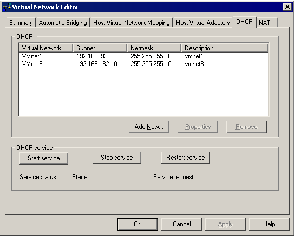Contents
Previous Next
Selecting IP Addresses on a Host-Only Network or NAT Configuration
A host-only network uses a private virtual network. The host and all virtual machines configured for host-only networking are connected to the network through a virtual switch. Typically all the parties on this private network use the TCP/IP protocol suite, although other communication protocols may be used.
A network address translation (NAT) configuration also sets up a private network, which must be a TCP/IP network. The virtual machines configured for NAT are connected to that network through a virtual switch. The host computer is also connected to the private network used for NAT via a host virtual adapter.
Each virtual machine and the host must be assigned addresses on the private network. This is typically done using the DHCP server that comes with GSX Server. Note that this server does not service virtual (or physical) machines residing on bridged networks.
Addresses can also be assigned statically from a pool of addresses that are not assigned by the DHCP server.
When host-only networking is enabled at the time GSX Server is installed, the network number to use for the virtual network is automatically selected as an unused private IP network number. To find out what network is used on a Windows host, choose Host > Virtual Network Settings and check the subnet number associated with the virtual network. On a Linux host, run ifconfig in a terminal.
A NAT configuration also uses an unused private network automatically selected when you install GSX Server. To find out what network is used on a Windows host, choose Host > Virtual Network Settings and check the subnet number associated with the virtual network. On a Linux host, run ifconfig in a terminal.
Using DHCP to assign IP addresses is simpler and more automatic than statically assigning them. Most Windows operating systems, for example, come preconfigured to use DHCP at boot time, so Windows virtual machines can connect to the network the first time they are booted, without additional configuration. If you want your virtual machines to communicate with each other using names instead of IP addresses, however, you must set up a naming convention, a name server on the private network, or both. In that case it may be simpler to use static IP addresses.
In general, if you have virtual machines you intend to use frequently or for extended periods of time, it is probably most convenient to assign them static IP addresses or to configure the VMware DHCP server to always assign the same IP address to each of these virtual machines.
Configuring the DHCP Server on a Linux Host
On a Linux host, you configure the host-only DHCP server by editing the DHCP configuration file for VMnet1 (/etc/vmware/vmnet1/dhcp/dhcp.conf). To configure the DHCP server for the NAT network, edit the configuration file for VMnet8 (/etc/vmware/vmnet8/dhcp/dhcp.conf).
Editing the DHCP server configuration file requires information that is best obtained directly from the DHCP server documentation. Consult the manual pages dhcpd(8) and dhcpd.conf(8).
Configuring the DHCP Server on a Windows Host
On a Windows host, you configure the DHCP server using the Virtual Network Editor (Host > Virtual Network Settings > DHCP).
Select the virtual network for which you want to change settings and click Properties.
Make the desired changes, then click OK.
Choosing the Method for Assigning IP Addresses
For virtual machines that you do not expect to keep for long, use DHCP and let it allocate an IP address.
For each host-only or NAT network, the available IP addresses are split up using the conventions shown in the tables below, where <net> is the network number assigned to your host-only or NAT network. GSX Server always uses a Class C address for host-only and NAT networks.
Address Use on a Host-Only Network
|
Range
|
Address use
|
Example
|
|
<net>.1
|
Host machine
|
192.168.0.1
|
|
<net>.2-<net>.127
|
Static addresses
|
192.168.0.2-192.168.0.127
|
|
<net>.128-<net>.253
|
DHCP-assigned
|
192.168.0.128-192.168.0.253
|
|
<net>.254
|
DHCP server
|
192.168.0.254
|
|
<net>.255
|
Broadcasting
|
192.168.0.255
|
Address Use on a NAT Network
|
Range
|
Address use
|
Example
|
|
<net>.1
|
Host machine
|
192.168.0.1
|
|
<net>.2
|
NAT device
|
192.168.0.2
|
|
<net>.3-<net>.127
|
Static addresses
|
192.168.0.3-192.168.0.127
|
|
<net>.128-<net>.253
|
DHCP-assigned
|
192.168.0.128-192.168.0.253
|
|
<net>.254
|
DHCP server
|
192.168.0.254
|
|
<net>.255
|
Broadcasting
|
192.168.0.255
|
